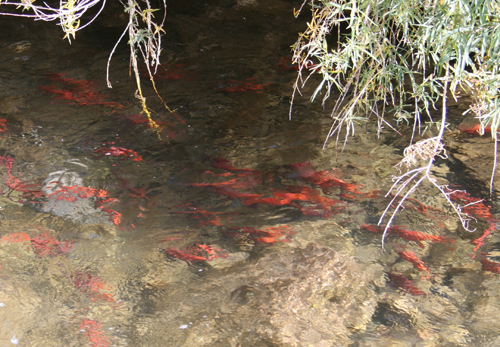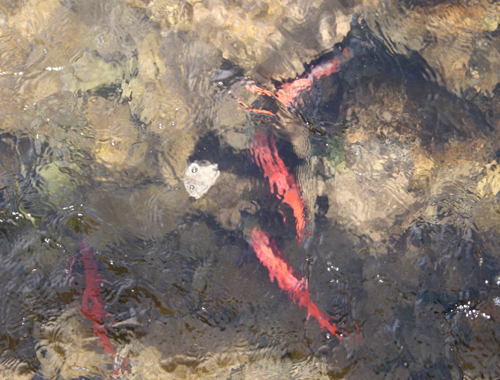
Copyright 2008 Mary-Ann Muffoletto
A little over a week ago, I saw my first kokanee salmon run up Little Bear River just east of Porcupine Reservoir. This year, researchers counted over 10,000 fish within a mile of the reservoir. That’s a record number. My friends and I marveled at these wriggling flashes of color as they struggled upstream. It inspired me to spend the week reading about salmon. Here’s what I learned.
First of all it surprised me that salmon and trout are so close genetically. Along with whitefish and grayling, they form the family Salmonidae, but salmon and trout are the most similar. The main difference between them is that salmon generally migrate from their freshwater birthplace to the sea to get more and better food. And then they return to spawn in freshwater rivers and streams where there are fewer predators. And generally – although it’s not true for all – salmon spawn once and die while trout go through a number of spawning cycles.
The Pacific Sockeye salmon resembles a silvery rainbow trout during most of its life. But when it spawns, the male especially undergoes a miraculous transformation. His head turns green, his body turns a bright red, and his back grows a bump. And his jaw begins to hook until he’s got a pronounced overbite. There’s a lot of jostling over females during breeding, and the humpback and hooked jaw helps him intimidate other male fish so he can fertilize more female eggs. And the red color is considered highly attractive to the opposite sex.

Copyright 2008 Mary-Ann Muffoletto

Courtesy & Copyright 2008 Mary-Ann Muffoletto
Because it flexibly defines a lake as its ocean, the kokanee has become a popular fish for reintroduction into western lakes and reservoirs. In 1922, the kokanee was first introduced for sport fishing into Utah’s Bear Lake. Nowadays you can see them spawn in the Little Bear River out of Porcupine Reservoir, Sheep Creek near Flaming Gorge Reservoir, and tributary streams of Strawberry Reservoir.
If you hurry, you can still catch the last of the spawning kokanees, their bright red bodies an aquatic response to the flaming Utah maple on the surrounding hillsides.
Special thanks to Charles Hawkins (Watershed Sciences, College of Natural Resources, Utah State University) , Phaedra Budy (Utah Cooperative Fish and Wildlife Research Unit, College of Natural Resources, Utah State University) and Bret Roper (US Forest Service, Fish & Aquatic Ecology Unit, Logan, UT) for their comments on this piece.
Credits:
Photo: Courtesy of and Copyright 2008 Mary-Ann Muffoletto
Text: Stokes Nature Center: Holly Strand
Sources & Additional Reading
Aggies Help State with Fall Salmon Count 2008. Utah State Today. Sept 25, 2008. https://www.usu.edu/today/story/aggies-help-state-with-fall-salmon-count [Updated October 31, 2024, formerly https://www.usu.edu/ust/index.cfm?article=30698]
Coates, P. 2006. Salmon. London: Reaktion Books https://reaktionbooks.co.uk/work/salmon-2
Craig, J.K., and Foote, C.J. 2001. Countergradient variation and secondary sexual color: phenotypic convergence promotes genetic divergence in carotenoid use between sympatric anadromous and nonanadromous morphs of sockeye salmon (Oncorhynchus nerka), Evolution 55(2), 2001, pp. 380-391. https://pubmed.ncbi.nlm.nih.gov/11308094/
Utah Division of Wildlife Resources. Kokanee (Oncorhynchus nerka). Wildlife notebook Series No. 10.https://redrockadventure.com/fishing/species/kokanee-dwr-booklet.pdf (accessed Oct 31, 2021)
formerly held at https://wildlife.utah.gov/publications/pdf/newkokan.pdf (accessed Oct 3, 2008)
See also:
Stewart, Ron, UDWR, Kokanee Salmon in Strawberry Reservoir https://www.redrockadventure.com/fishing/Strawberry/strawberry_kokanee.htm
Where you can see bright red kokanee salmon in Utah this fall, Utah Division of Wildlife Resources, August 31, 2023, https://wildlife.utah.gov/news/utah-wildlife-news/1746-where-to-see-bright-red-kokanee-salmon-this-fall.html [Updated November 1, 2024]
Isaacson, Samantha, Kokanee Salmon Run the River, The Utah Statesman(USU Student Newspaper), October 21, 2024 https://usustatesman.com/kokanee-salmon-run-the-river/ [Accessed October 31, 2024]
